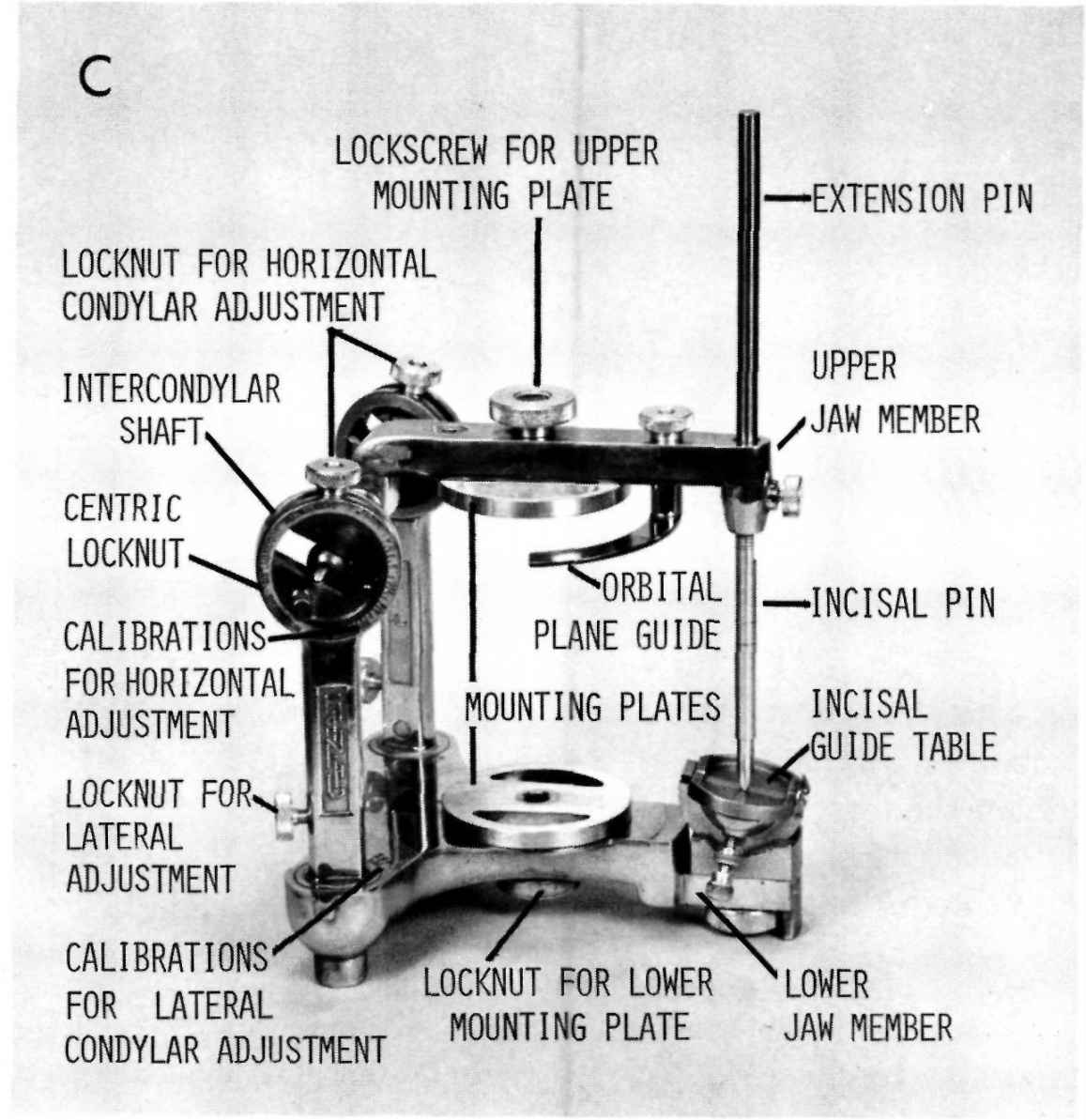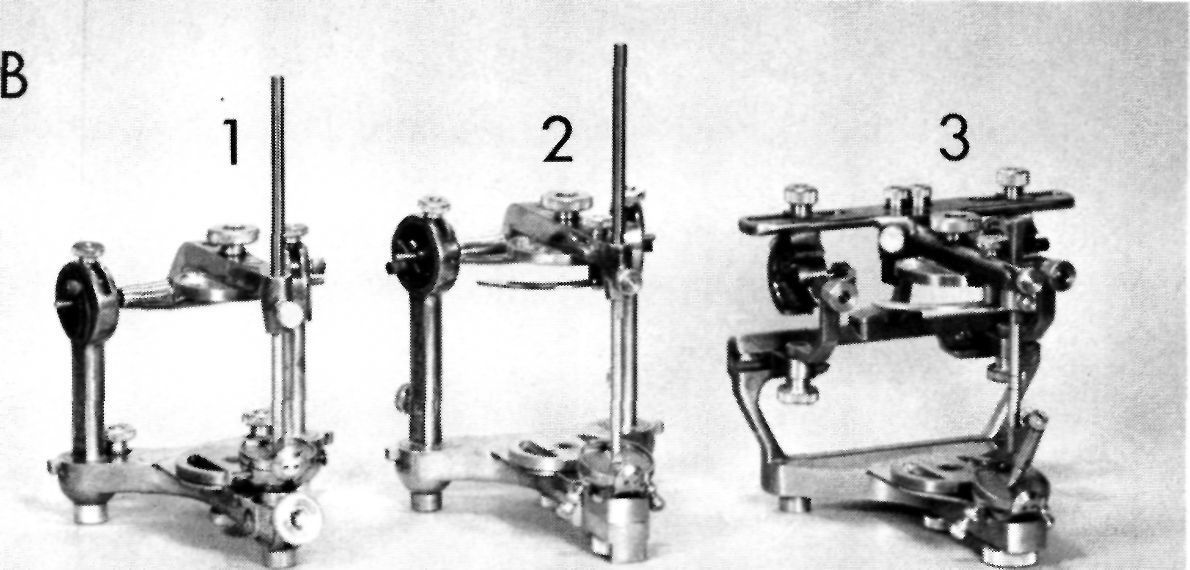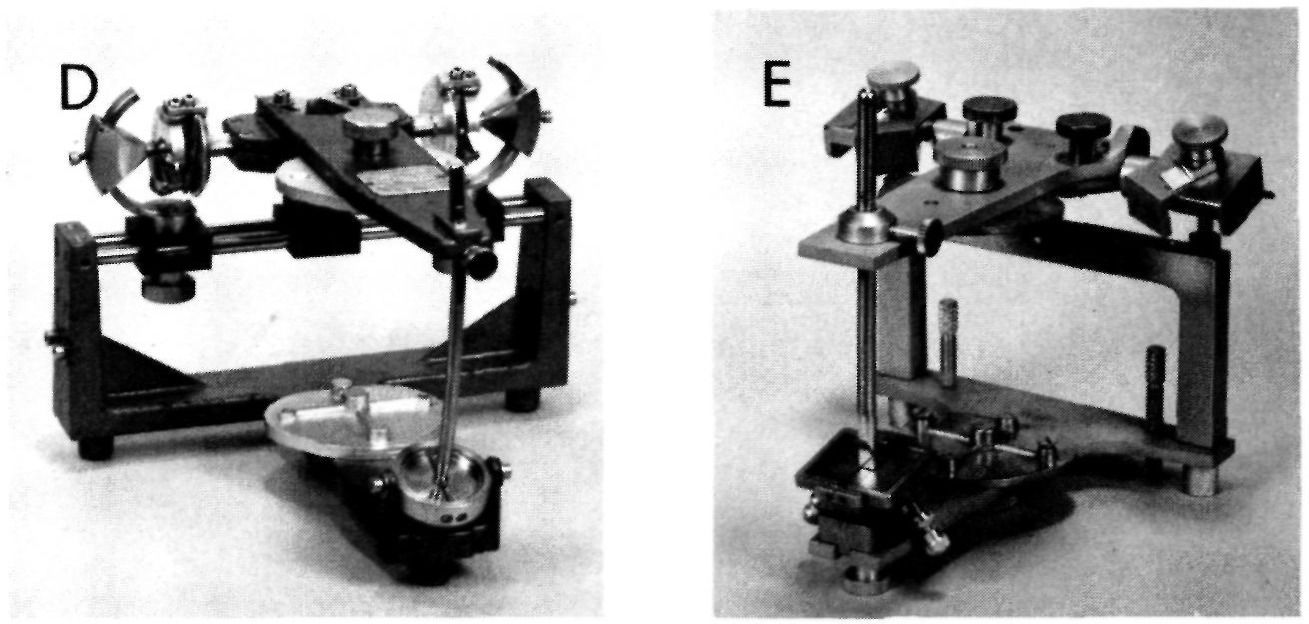
Figure D is a Gnatholator, a fully adjustable articulator, which is adjusted by means of a pantograph and is said to duplicate jaw movements. This type of articulator is used primarily in full mouth reconstruction when the occlusal surfaces of the natural teeth are to be restored.
The Stewart articulator is another fully adjustable articulator similar in appearance and use to the Gnatholator. The Whip-Mix articulator (Figure E) is a student model of the Stewart articulator. The Whip-Mix instrument is a semi-adjustable articulator in that it accepts centric and protrusive jaw relation records only. Lateral jaw relation records may be used but the arbitrary intercondylar distances will not permit accurate adjustment to all of these records.
Each type of articulator has its place in the dental laboratory. The nonadjustable articulators are used to make simple dental appliances, such as all plastic temporary partial dentures. Semi-adjustable articulators are used in many phases of dentistry, but are of particular importance in complete and partial denture construction. Some dentists use semi-adjustable instruments for crown and bridge procedures. The fully adjustable articulators are used by relatively few dentists and, as stated previously, are used primarily for full mouth reconstruction procedures. Additional training and experience beyond that offered in most dental schools is necessary before a dentist or technician can intelligently use one of the fully adjustable instruments.
JAW AND ARTICULATOR MOVEMENTS
The complexity of an articulator determines the movements of which it is capable. A nonadjustable, fixed-hinge articulator can only open and close. A nonadjustable articulator with fixed condylar guides can make lateral movements, but these movements are dictated by the articulator.
Semi-adjustable articulators are designed to be adjusted so that the articulator movements will simulate the jaw movements of the patient. The word simulate is used because the condylar paths have a fixed contour which cannot be altered and the distance between the condyles cannot be varied. Even though semi-adjustable articulators cannot duplicate jaw movements, most prosthodontists consider these instruments satisfactory for the construction of removable dental appliances.
The movements a human mandible can make are infinite. Within certain boundaries, the mandible is capable of vertical, horizontal, and protrusive movements, as well as combinations of these movements. In most articulators, the concern is to record the border movements—those points which limit the movement of the mandible. When your head is held still, the mandible is limited in movement by the temporomandibular joint, the muscles, and the ligaments attached to the mandible. These limitations determine the border movements.
Theoretically, when border movements are recorded accurately, it is assumed that the articulator accepting these records will simulate the random movements of the mandible. Dental appliances and restorations constructed in harmony with the border movements should function effectively and comfortably for the patient.
A pantograph is an instrument which, when attached to the jaws, records all border movements. Advocates of fully adjustable gnathostatic articulators (examples are the Gnatholator and the Stewart articulator) believe that jaw movements can be duplicated on their articulators by using a pantograph.
All casts are mounted on articulators in centric relation (see definition below). Semi-adjustable and fully adjustable articulators are adjusted by using eccentric jaw (maxillomandibular) relationship records. Articulators with a fixed intercondylar distance, such as a Hanau H-2, accept only one eccentric jaw relationship record, a protrusive record. This is made by having the patient hold his jaw in a protruded relationship while a record is being made. This record is then used to adjust the horizontal condylar inclination (Section 8, Figure 26).
Articulators with a variable intercondylar distance will accept three eccentric jaw relationship records, a protrusive record and right and left lateral jaw relationship records. More accurate restorations are possible on these fully adjustable instruments.
DEFINITION OF TERMS
A technician must be familiar with several terms in order to use an articulator intelligently. An understanding of these terms will make communication easier between technician and dentist.
Centric Relation is “(1) the most posterior relation of the mandible to the maxillae at the established vertical dimension; (2) the relation of the mandible to the maxillae when the condyles are in their most posterio-superior unstrained position in the glenoid fossae, from which unstrained lateral movements can be made at the occluding vertical relation normal for the individual. Centric relation is a relation that can exist at any degree of jaw separation.” (CCDT) It is a designation of a horizontal relation.
The importance of centric relation in complete denture construction is that it is the one position which a patient is able to repeat. When a person loses all of his teeth, he loses most of the tactile sense which permits him to make repeated identical eccentric jaw closures. Thus, many edentulous individuals are unable to repeat any jaw position except centric relation. It is the dentist’s responsibility to record centric relation and the technician’s responsibility to maintain this relationship through careful laboratory procedures. If centric relation is recorded improperly, the completed dentures will not occlude or function correctly in the mouth.
Centric Occlusion is “the relation of opposing occlusal surfaces that provides the maximum planned contact and/or intercuspation. It should exist when the mandible is in centric relation to the maxillae.” (CCDT) Centric occlusion is a “tooth to tooth” relationship while centric relation is a “bone to bone” relationship. In complete denture construction it is essential that centric occlusion is in harmony with centric relation even though this condition does not always occur in the natural dentition. Edentulous casts are mounted in centric relation and the artificial teeth are arranged in centric occlusion.
In correct dental terminology, centric is an adjective and should never be used alone. To speak of “recording centric” is incorrect since it is impossible to know if centric occlusion or centric relation has been recorded.
Vertical Dimension is “a vertical measurement of the face between any two arbitrarily selected points that are conveniently located one above and one below the mouth, usually in the midline.” (CCDT)
There are two types of vertical dimension which are involved in restorative dentistry and in complete and partial denture prosthodontics. Rest vertical dimension is “the vertical dimension of the face with the jaws in rest relation.” (CCDT) This is the position of the jaws when all the muscles are relaxed. Occlusal vertical dimension
Stay updated, free dental videos. Join our Telegram channel

VIDEdental - Online dental courses




